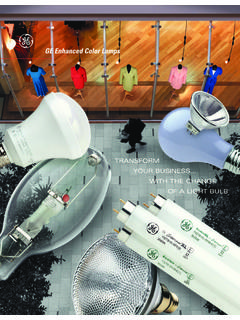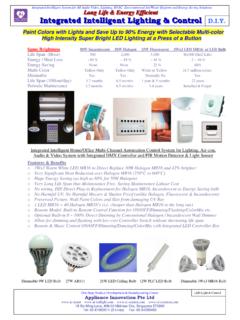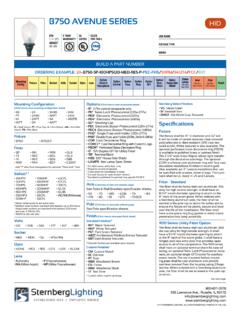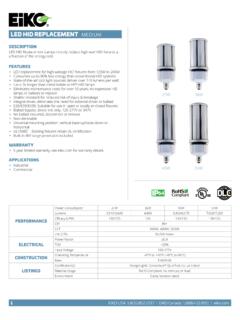Transcription of Used Electric Lamps & Small Ballasts - michigan.gov
1 USED Electric Lamps & Small Ballasts Electric Lamps or bulbs include fluorescent, high intensity discharge (HID), sodium vapor or high pressure sodium, mercury vapor, neon, metal halide, and incandescent Lamps . Cathode ray tubes (CRTs) from computers, televisions, etc may be handled as either Electric Lamps or consumer electronics universal waste. Some vehicle headlights are HID Lamps . Residents and companies and other facilities are encouraged to buy Lamps with the lowest mercury content that meet their lighting needs. Information about environmental purchasing can be found at and at I. How should residents manage used Lamps ? Households are exempt from the hazardous waste regulations, but residents are encouraged to: Avoid breaking Lamps so mercury will not be released.
2 Package Lamps carefully when storing & transporting them. Check with the household hazardous waste program or recycler you plan to use for packaging recommendations. Contact your local recycling coordinator, local household hazardous waste collection, or go to to find recycling options. Not all programs accept used Lamps at this time so encourage your program to consider taking them. Dispose of Lamps with other household trash only if the garbage hauler and landfill will accept them. Contact them for more information, but MDEQ strongly recommends that Lamps are safely recycled whenever possible. II. How do companies and regulated facilities know Lamps are hazardous waste?
3 9 All generators of waste, except households, must determine by knowledge and/or testing if their waste Lamps are hazardous waste. Keep characterization records at least 3 years after the last shipment. Characterization of the Lamps can be done by: Obtaining lamp maker s written claim that states the Lamps are, or are not, hazardous waste. Contact the lamp supplier or manufacturer to get a Material Safety Data Sheet (MSDS) or advertising literature that has this information. Some MSDS are available on the Internet. The information may include words such as Lamps are not a RCRA waste , Lamps are not a Resource Conservation and Recovery Act waste , Lamps are a non-haz waste , or Lamps are not a hazardous waste.
4 Lamps that are not hazardous waste usually have green lamp etching or green components like green end caps. They are often called green tipped or low mercury bulbs. These green bulbs still contain mercury but are designed so they pass the test used to characterize hazardous waste for toxicity. Assuming they are hazardous. Having them tested using Toxicity Characteristic Leaching Procedure (TCLP). Used Lamps are considered hazardous waste when: Mercury concentration mg/L; would have D009 waste code. (fluorescent Lamps , sodium-vapor Lamps , high - and low-pressure mercury vapor Lamps , and HID Lamps ) Cadmium concentration 1 mg/L; would have D006 waste code.
5 (incandescent bulbs) Lead concentration 5 mg/L; would have D008 waste code. (incandescent bulbs and color CRTs) : Not properly characterizing Lamps and keeping records are common violations. michigan DEPARTMENT OF ENVIRONMENTAL QUALITY WASTE AND HAZARDOUS MATERIALS DIVISION Jennifer M. Granholm, Governor Steven E. Chester, Director PO BOX 30241 LANSING MI 48909-7741 Environmental Assistance Center 800-662-9278 517-335-2690 III. What are the regulations for managing a company s waste Lamps ? michigan companies are encouraged to follow the universal waste rule (R ) which adopts many of the federal universal waste regulations.
6 The management requirements will depend on the amount of all universal waste at the site most companies are Small quantity handlers (SQH); but if a company has more than 11,000 lbs of all universal wastes at any time, then they must meet large quantity handler (LQH) requirements. That is equivalent to about 17,000 four foot Lamps if Lamps are the only universal waste on-site. Other universal waste includes batteries, electronic equipment, mercury switches, thermometers, thermostats and other devices containing elemental mercury, certain pesticides, and pharmaceuticals. This guidance provides a summary for handling Lamps . Another option for the company is to follow the hazardous waste regulations for handling, storage, treatment and disposal (Part 111 of michigan s Natural Resources and Environmental Protection Act, 1994 451, as amended ( 451) and rules, and Subtitle C of the Federal Resource Conservation and Recovery Act (RCRA) of 1976, as amended regulations.)
7 The specific requirements will depend on a company s hazardous waste generator status large quantity, Small quantity, or conditionally exempt Small quantity generator. Hazardous Waste Generator Status Categories In ONE month, the total amount of ALL nonacute hazardous waste is generated and accumulated at the following volumes: Large Quantity Generator (LQG): more than 2,200 pounds [and/or more than pounds of acutely and severely toxic hazardous waste is generated.] Small Quantity Generator (SQG): 220 pounds to less than 2,200 pounds. Accumulation never exceeds 13,200 pounds. Conditionally Exempt Small Quantity Generator (CESQG): less than 220 pounds.
8 Accumulation never exceeds 2,200 pounds. There are also storage time limits and other requirements. See the Waste Characterization guidance. Contact the DEQ Environmental Assistance Center at 800-662-9278 or your local DEQ Waste and Hazardous Materials Division district office, or download hazardous waste guidance at for more hazardous waste information. The electronic federal regulations are at How must used Lamps be stored at companies? 9 Store Lamps in containers that are kept closed and handled to minimize breakage during normal conditions. Place waste Lamps in sturdy packaging or containers. If going to be used for shipment, have it functionally equivalent to that used to ship new Lamps .
9 Some recyclers may provide shipping containers. A company could make a storage unit to hold the bulbs until the hauler arrives. Check with the recycler before applying tape around the Lamps and to determine what kind of packaging they want used. It is recommended to seal full packages with tape. : Improper storage, such as leaning Lamps against a wall, placing them behind doorways, stuffing them in rafters, storing outdoors, and throwing them in dumpsters when not allowed, are common violations. 9 Do not exceed the accumulation time limits. If managing Lamps as universal waste, store no longer than one year. If a longer time period is needed to economically collect the bulbs for recycling, discuss with the Waste and Hazardous Materials Division District Office if an extension can be granted.
10 Document the time period by any of the following: Example of one type of universal waste storage. End cap removed for taking picture. Date the container when the first waste bulb was put into it, or date the Electric lamp , Keep a log or inventory, or Use another method to demonstrate how long the universal waste has been accumulated. Used Electric Lamps & Small Ballasts August 2006 page 2 of 7 If managing Lamps as hazardous waste, they may be kept on-site up to: 90 days for large quantity generators (LQG). 180 days (or 270 days if shipping over 200 miles) for Small quantity generators (SQG). Conditionally exempt Small quantity generators (CESQG) do not have a time limit unless all hazardous waste on-site exceeds 2,200 pounds.














